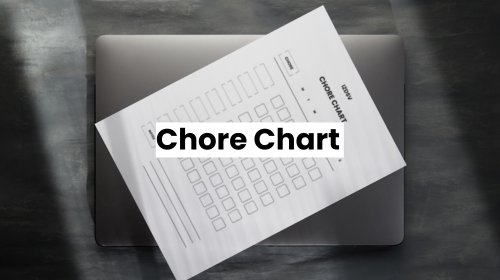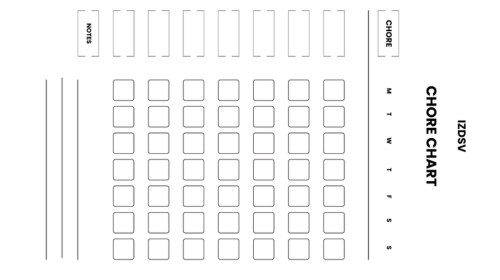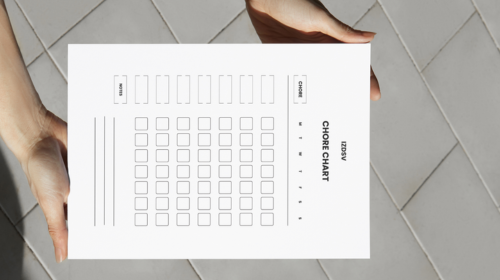Organize Your Home with Household Cleaning Schedule Template
What is a Household Cleaning Schedule?
A household cleaning schedule is a structured plan that outlines when specific cleaning tasks should be performed throughout your home. It serves as a roadmap for maintaining cleanliness by organizing tasks into daily, weekly, monthly, and seasonal categories.
- A comprehensive list of all cleaning tasks needed for your home
- A timeline showing when each task should be completed
- A system for dividing responsibilities among household members
- A method to ensure no cleaning tasks are forgotten or neglected
- A customizable framework that can be adjusted based on your specific needs
Understanding the Importance of a Cleaning Schedule
A cleaning schedule prevents your home from becoming overwhelmingly dirty by breaking maintenance into manageable, regular tasks. It eliminates the stress of spontaneous cleaning marathons by creating a systematic approach to household maintenance.
- Creates structure and prevents cleaning tasks from piling up
- Helps maintain a consistently clean environment rather than cycles of mess and deep cleaning
- Reduces the mental load of deciding what needs to be cleaned and when
- Provides accountability and clear expectations for household members
- Prevents arguments about cleaning responsibilities
- Ensures that easily forgotten tasks (like cleaning baseboards or changing air filters) get done
Benefits of Using a Cleaning Checklist
A cleaning checklist provides visual confirmation of completed tasks and offers a sense of accomplishment as you check items off. It serves as both a reminder system and a motivational tool that keeps you on track with your cleaning routine.
- Creates a clear record of what has been completed and what still needs attention
- Provides satisfaction and motivation as you check off completed tasks
- Ensures consistency in cleaning standards and methods
- Helps new household members learn the cleaning routine quickly
- Makes it easy to delegate tasks to family members or hired help
- Can be adjusted seasonally or as household needs change
- Reduces the cognitive load of remembering what needs to be cleaned
How a Cleaning Schedule Can Improve Your Routine
A cleaning schedule transforms the overwhelming task of maintaining a clean home into a series of manageable daily habits. It integrates cleaning into your lifestyle rather than making it an occasional disruptive event.
- Distributes cleaning tasks throughout the week to prevent weekend cleaning marathons
- Creates daily habits that maintain cleanliness with minimal effort
- Reduces time spent cleaning through regular maintenance rather than deep cleaning neglected areas
- Prevents cleaning emergencies before guests arrive
- Establishes a healthy routine that becomes second nature over time
- Allows for better time management and planning around cleaning tasks
- Creates a consistently clean environment that improves overall quality of life
How to Create a Printable Cleaning Schedule Template
Creating a printable cleaning schedule template involves designing a structured document that organizes cleaning tasks in a visually appealing and practical format. The process requires thoughtful consideration of your specific household needs and cleaning patterns to ensure the template will be useful in the long term.
- Begin by selecting a format (spreadsheet, word processor, or dedicated template software)
- Choose between daily, weekly, monthly, and seasonal sections
- Include space for task descriptions, frequency, and checkboxes
- Consider color-coding different areas or types of cleaning tasks
- Add a section for rotating or occasional deep-cleaning tasks
- Ensure the design is clean and uncluttered for easy reading
- Include space for notes or special instructions
- Make sure the template can be easily printed on standard paper
- Consider laminating the final product so it can be reused with dry-erase markers
Steps to Design Your Own Cleaning Schedule
Designing your own cleaning schedule requires careful assessment of your household’s specific needs and honest evaluation of your available time and cleaning preferences. The most effective cleaning schedules are those tailored to your unique situation rather than generic templates.
- Inventory all cleaning tasks needed throughout your home
- Categorize tasks by frequency (daily, weekly, monthly, seasonal)
- Assess how long each task typically takes to complete
- Consider your weekly schedule and identify ideal cleaning times
- Distribute tasks evenly throughout the week to avoid cleaning overload
- Account for household members’ availability and cleaning abilities
- Start with a draft schedule and test it for 2-3 weeks
- Refine the schedule based on what works and what doesn’t
- Gradually build in more challenging or less frequent tasks
Essential Elements of a House Cleaning Schedule
A comprehensive house cleaning schedule contains several crucial components that ensure it remains functional and adaptable to changing household needs. The most effective schedules balance thoroughness with practicality to create a sustainable cleaning routine.
- Clear categorization of tasks by frequency (daily, weekly, monthly, seasonal)
- Room-by-room breakdown of specific cleaning tasks
- Estimated time requirements for each task
- Assignment of responsibilities to specific household members
- Space for checking off completed tasks
- Flexibility for unexpected events or schedule changes
- Instructions for specific cleaning methods when needed
- Products or tools required for particular tasks
- Rotating deep-cleaning tasks that don’t need weekly attention
- Special considerations for homes with pets, children, or allergies
- Review and reset mechanism (weekly or monthly)
Utilizing a Template for Efficiency
Utilizing a cleaning schedule template streamlines your household maintenance by eliminating the need to repeatedly plan and remember routine cleaning tasks. An effective template serves as both a planning tool and accountability system that makes cleaning more efficient and consistent.
- Start with a pre-made template and customize it to your specific needs
- Place the template in a visible location where all household members can see it
- Use digital templates that can sync across devices for on-the-go reminders
- Set up notification systems for upcoming or overdue cleaning tasks
- Incorporate the template into your regular planning routine
- Review completed tasks weekly to celebrate progress
- Adjust the template seasonally as cleaning needs change
- Use the template to train new household members or cleaning help
- Track efficiency over time to optimize your cleaning schedule
What Should Be Included in a Weekly Cleaning Checklist?
A weekly cleaning checklist should include regular maintenance tasks that keep your home consistently clean and prevent dirt buildup. These tasks strike a balance between daily quick cleanups and more intensive monthly deep cleaning.
- Vacuuming and/or mopping all floors
- Dusting furniture, shelves, and surfaces
- Changing and washing bed linens
- Cleaning bathroom surfaces (toilet, sink, shower, tub)
- Wiping down kitchen counters and appliance exteriors
- Cleaning mirrors and glass surfaces
- Emptying all trash cans
- Spot cleaning walls and doors
- Washing bath mats and kitchen rugs
- Scrubbing the toilet bowl
- Wiping down light switches and doorknobs
- Cleaning inside the microwave
- Decluttering common areas
Daily and Weekly Cleaning Tasks to Consider
Daily and weekly cleaning tasks form the foundation of a well-maintained home, with daily tasks preventing buildup and weekly tasks providing more thorough attention. The right combination creates a manageable routine that keeps your home consistently clean without requiring marathon cleaning sessions.
Daily tasks:
- Making beds
- Washing dishes/running dishwasher
- Wiping down kitchen counters after meals
- Quick bathroom sink and counter wipe-down
- Spot sweeping or vacuuming high-traffic areas
- Sorting mail and clearing clutter
- Doing a load of laundry if needed
- Taking out trash and recycling when full
Weekly tasks:
- Thorough vacuuming of all carpets and rugs
- Mopping hard floors
- Complete bathroom cleaning
- Dusting all surfaces
- Changing bed sheets
- Cleaning kitchen appliance exteriors
- Laundering towels
- Wiping down cabinet fronts
- Cleaning the inside of trash cans
Creating a House Cleaning Checklist by Room
Creating a room-by-room cleaning checklist ensures that no area of your home is overlooked and helps compartmentalize cleaning tasks for better efficiency. This approach allows you to focus completely on one space before moving to the next, which can be more satisfying and effective.
Kitchen:
- Wipe down countertops and backsplash
- Clean the stovetop and oven exterior
- Wipe down refrigerator exterior and handles
- Clean the microwave inside and out
- Sanitize sink and faucet
- Empty and clean trash can
- Sweep and mop floors
- Clean small appliances
Bathrooms:
- Scrub toilet (bowl, seat, base, and tank)
- Clean shower/tub
- Wipe down counters and sink
- Clean mirror
- Replace towels
- Empty trash
- Sweep and mop the floor
- Restock toilet paper and toiletries
Bedrooms:
- Change bed linens
- Dust furniture
- Vacuum the floor and under the bed
- Clear surfaces of clutter
- Empty trash bins
- Organize nightstand
- Dust light fixtures and ceiling fans
Living Areas:
- Dust shelves, tables, and decorative items
- Vacuum upholstery and under cushions
- Clean electronics screens
- Vacuum or sweep floors
- Declutter surfaces
- Straighten pillows and throws
- Clean windows and mirrors
Seasonal Cleaning Tasks to Add to Your Checklist
Seasonal cleaning tasks address deeper cleaning needs that don’t require weekly attention but are essential for home maintenance and preventing long-term issues. These quarterly or biannual tasks help keep your home in excellent condition year-round.
Spring cleaning tasks:
- Wash windows inside and out
- Deep clean carpets and upholstery
- Clean under and behind furniture
- Declutter and organize closets
- Clean ceiling fans and light fixtures
- Wash curtains and blinds
- Clean oven interior
- Power wash exterior surfaces
Summer cleaning tasks:
- Clean air conditioning filters
- Organize garage/shed
- Clean outdoor furniture
- Wash outdoor cushions
- Clean grill thoroughly
- Check and clean window screens
- Pressure wash deck/patio
Fall cleaning tasks:
- Clean gutters
- Check the weather stripping
- Clean the chimney if applicable
- Turn and flip mattresses
- Clean heating vents and replace filters
- Store summer items properly
- Deep clean kitchen appliances
Winter cleaning tasks:
- Organize holiday decorations when storing
- Deep clean guest areas
- Clean refrigerator coils
- Sanitize the garbage disposal
- Rotate and clean area rugs
- Purge unwanted items before year-end
- Clean inside drawers and cabinets
How to Use a Cleaning Schedule for Effective Home Management?
Using a cleaning schedule effectively transforms household management from a source of stress to a streamlined system of maintenance. The key to success lies in consistent implementation and gradual habit formation rather than trying to perfect everything at once.
- Start with a realistic schedule that accounts for your actual availability
- Post the schedule in a visible location where all household members can see it
- Commit to following the schedule for at least 30 days to establish new habits
- Track completed tasks to provide motivation and accountability
- Build in flexibility for unexpected events or particularly busy days
- Review and adjust the schedule monthly based on what’s working
- Use timers to keep cleaning sessions focused and prevent perfectionism
- Incorporate quick 10-15 minute cleaning bursts throughout the day
- Celebrate consistency rather than perfection
- Gradually increase cleaning tasks as routines become established
- Consider using apps or digital reminders to help stay on track
Integrating Daily and Weekly Cleaning Routines
Integrating daily and weekly cleaning routines creates a layered approach that prevents dirt buildup while maintaining overall cleanliness. This systematic method ensures that small tasks don’t become overwhelming projects through consistent attention.
- Establish morning and evening mini-routines that take 10-15 minutes each
- Link daily cleaning tasks to existing habits (clean the bathroom while the shower heats up)
- Dedicate specific days to particular weekly tasks (Monday for bathrooms, Tuesday for dusting)
- Use the “one-touch rule” – handle items once, rather than moving clutter around
- Implement the “two-minute rule” – if a task takes less than two minutes, do it immediately
- Create cleaning stations in different areas of your home with the necessary supplies
- Prepare for the next day by doing a quick 10-minute reset each evening
- Bundle similar tasks together to improve efficiency
- Use transition times between activities for quick cleaning tasks
- Keep cleaning tools accessible where they’ll be used
- Maintain a “clean as you go” mindset for cooking and other activities
Assigning Chores with a Cleaning Schedule
Assigning chores with a cleaning schedule creates clear expectations for all household members and distributes the workload fairly. An effective system accounts for each person’s abilities, preferences, and schedules while ensuring that all necessary tasks are covered.
- Create a family meeting to discuss cleaning responsibilities and expectations
- Consider age-appropriate tasks for children and teens
- Rotate less desirable chores among household members
- Match tasks to individual strengths and preferences when possible
- Define what “clean” means for each task to avoid confusion
- Create visual guides for younger children or household members new to specific tasks
- Build in accountability systems like chore charts or checking in at family meetings
- Consider using reward systems for completed tasks, especially for children
- Schedule “all hands” cleaning times when everyone works simultaneously
- Pair up household members for more challenging tasks
- Balance the workload based on each person’s other responsibilities
- Use technology like shared calendar apps to send reminders about assigned tasks
Adapting Your Schedule for Busy Lifestyles
Adapting your cleaning schedule for a busy lifestyle involves prioritizing essential tasks, maximizing efficiency, and building flexibility into your system. A realistic approach prevents burnout and ensures that basic cleanliness is maintained even during hectic periods.
- Identify your true “non-negotiable” cleaning tasks versus those that can wait
- Focus on high-visibility and high-use areas when time is limited
- Break tasks into 5-15 minute segments that can fit between other activities
- Keep cleaning supplies in multiple locations to eliminate setup time
- Plan more intensive cleaning during less busy seasons or weekends
- Consider outsourcing certain tasks if the budget allows
- Implement the “one room a day” approach to maintain momentum
- Use time-saving tools like robot vacuums or steam mops
- Lower perfectionist standards during particularly busy weeks
- Create “maintenance mode” and “deep cleaning mode” schedules for different periods
- Build in recovery periods after busy times to catch up on deferred tasks
- Use audiobooks, podcasts, or favorite music to make cleaning sessions more enjoyable
Tips for Sticking to Your House Cleaning Schedule
Sticking to a house cleaning schedule requires building sustainable habits that work with your lifestyle rather than against it. The most effective cleaning schedules become second nature over time, reducing the mental effort needed to maintain a clean home.
- Start with a schedule that’s slightly less ambitious than you think you can handle
- Set specific days and times for cleaning tasks rather than vague intentions
- Use the “don’t break the chain” method by marking completed days on a calendar
- Build in accountability by sharing your schedule with household members
- Create a pleasant cleaning environment with good lighting, music, or podcasts
- Keep cleaning supplies well-stocked and easily accessible
- Use timers to make cleaning sessions feel manageable (25-minute Pomodoro sessions work well)
- Pair cleaning with something enjoyable (listen to audiobooks or favorite music)
- Establish trigger routines that automatically prompt cleaning (like making coffee before morning kitchen wipe-down)
- Take before-and-after photos to visualize progress
- Create a reward system for consistently following your schedule
- Troubleshoot recurring obstacles and adjust your schedule accordingly
How to Stay Motivated with Chores
Staying motivated with chores involves finding personal meaning in the cleaning process and creating systems that generate positive feedback loops. Shifting your mindset from viewing cleaning as a burden to seeing it as self-care can transform your relationship with household maintenance.
- Connect cleaning to your core values (hospitality, health, creating a sanctuary)
- Break larger tasks into smaller milestones with clear completion points
- Gamify your cleaning with timing challenges or point systems
- Create cleaning “sprints” with short, focused cleaning sessions followed by breaks
- Use high-quality tools and products that make cleaning more pleasant
- Celebrate small wins by acknowledging completed tasks
- Join online cleaning communities for inspiration and accountability
- Follow cleaning influencers for motivation and new techniques
- Focus on how you’ll feel when you’re done rather than the process itself
- Add elements of play or competition when cleaning with others
- Track streaks of consistent cleaning days
- Periodically switch up your cleaning routine to prevent boredom
- Find satisfaction in the meditative aspects of repetitive cleaning tasks
Setting Realistic Cleaning Goals
Setting realistic cleaning goals requires honest assessment of your available time, energy levels, and the actual needs of your household. Sustainable goals acknowledge the reality of your life rather than an idealized version of what you “should” accomplish.
- Analyze how long tasks actually take rather than how long you think they should take
- Account for interruptions and transitions when planning cleaning sessions
- Start with maintaining basic cleanliness before adding deep cleaning tasks
- Consider your natural energy patterns when scheduling demanding tasks
- Acknowledge seasons of life when cleaning capacity may be reduced
- Focus on impact areas that create the greatest feeling of cleanliness
- Use the 80/20 rule—identify the 20% of cleaning tasks that create 80% of the impact
- Set progressive goals that build on success rather than dramatic overhauls
- Define what “clean enough” means for different areas of your home
- Break annual cleaning goals into quarterly targets
- Account for special events or visitors that might require additional cleaning
- Build buffer time into your schedule for unexpected messes or interruptions
Tracking Your Progress with a Cleaning Planner
Tracking your progress with a cleaning planner provides tangible evidence of your efforts and helps identify patterns in your cleaning habits. A well-designed tracking system offers both accountability and motivation by documenting your cleaning journey.
- Choose a tracking method that appeals to you (digital app, paper planner, wall chart)
- Record completed tasks with dates to establish your actual cleaning frequency
- Note how long different tasks take to improve future scheduling
- Color-code different types of cleaning for visual tracking
- Include a satisfaction rating for areas after cleaning to identify trouble spots
- Take a weekly “reset” time to evaluate the previous week’s accomplishments
- Track energy levels alongside cleaning to identify optimal cleaning times
- Note any obstacles that prevented scheduled cleaning
- Create a “done list” rather than just focusing on uncompleted tasks
- Use stickers or symbols to mark milestone achievements
- Compare the current cleaning capacity with previous months to see improvement
- Keep a “cleaning wins” section to document noticed improvements
- Photograph particularly satisfying cleaning transformations to include in your planner




